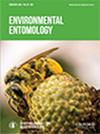Distinct communities under the snow: describing characteristics of subnivium arthropod communities.
IF 1.8
3区 农林科学
Q2 ENTOMOLOGY
引用次数: 0
Abstract
Arthropods are active during the winter in temperate regions. Many use the seasonal snowpack as a buffer against harsh ambient conditions and are active in a refugium known as the subnivium. While the use of the subnivium by arthropods is well established, far less is known about subnivium community composition, abundance, biomass, and diversity and how these characteristics compare with the community in the summer. Understanding subnivium communities is especially important given the observed and anticipated changes in snowpack depth and duration due to the changing climate. We compared subnivium arthropod communities with those active during the summer using pitfall trapping in northern New Hampshire. We found that compositions of ground-active arthropod communities in the subnivium differed from those in the summer. The subnivium arthropod community featured moderate levels of richness and other measures of diversity that tended to be lower than the summer community. More strikingly, the subnivium community was much lower in overall abundance and biomass. Interestingly, some arthropods were dominant in the subnivium but either rare or absent in summer collections. These putative "subnivium specialists" included the spider Cicurina brevis (Emerton 1890) (Araneae: Hahniidae) and 3 rove beetles (Coleoptera: Staphylinidae): Arpedium cribratum Fauvel, 1878, Lesteva pallipes LeConte, 1863, and Porrhodites inflatus (Hatch, 1957). This study provides a detailed account of the subnivium arthropod community, establishes baseline information on arthropod communities in temperate forests of northeastern North America, and explores the idea of subnivium specialist taxa that are highly active in winter and might be especially vulnerable to climate change.雪下的独特群落:描述雪下节肢动物群落的特征。
节肢动物在温带地区的冬季十分活跃。许多节肢动物利用季节性积雪作为缓冲,抵御恶劣的环境条件,并在被称为亚室内的缓冲地带活动。虽然节肢动物对亚栖息地的利用已得到公认,但人们对亚栖息地群落的组成、丰度、生物量和多样性以及这些特征与夏季群落的比较却知之甚少。由于气候不断变化,雪层深度和持续时间都会发生变化,因此了解亚室内群落尤为重要。我们在新罕布什尔州北部使用坑式陷阱比较了亚冬季节肢动物群落与夏季活跃的节肢动物群落。我们发现,亚室内地面活动节肢动物群落的组成与夏季不同。亚室内节肢动物群落的丰富度和其他多样性指标处于中等水平,往往低于夏季群落。更引人注目的是,亚夏季群落的总体丰度和生物量要低得多。有趣的是,有些节肢动物在亚栖息地占优势,但在夏季采集物中却很少见或没有。这些假定的 "亚栖息地专家 "包括蜘蛛 Cicurina brevis (Emerton 1890) (蛛形纲:Hahniidae)和 3 种啮齿目甲虫(鞘翅目:Staphylinidae):Arpedium cribratum Fauvel, 1878、Lesteva pallipes LeConte, 1863 和 Porrhodites inflatus (Hatch, 1957)。这项研究详细介绍了亚栖息地节肢动物群落,建立了北美东北部温带森林节肢动物群落的基线信息,并探讨了亚栖息地专科类群的概念,这些类群在冬季非常活跃,可能特别容易受到气候变化的影响。
本文章由计算机程序翻译,如有差异,请以英文原文为准。
求助全文
约1分钟内获得全文
求助全文
来源期刊

Environmental Entomology
生物-昆虫学
CiteScore
3.90
自引率
5.90%
发文量
97
审稿时长
3-8 weeks
期刊介绍:
Environmental Entomology is published bimonthly in February, April, June, August, October, and December. The journal publishes reports on the interaction of insects with the biological, chemical, and physical aspects of their environment. In addition to research papers, Environmental Entomology publishes Reviews, interpretive articles in a Forum section, and Letters to the Editor.
 求助内容:
求助内容: 应助结果提醒方式:
应助结果提醒方式:


